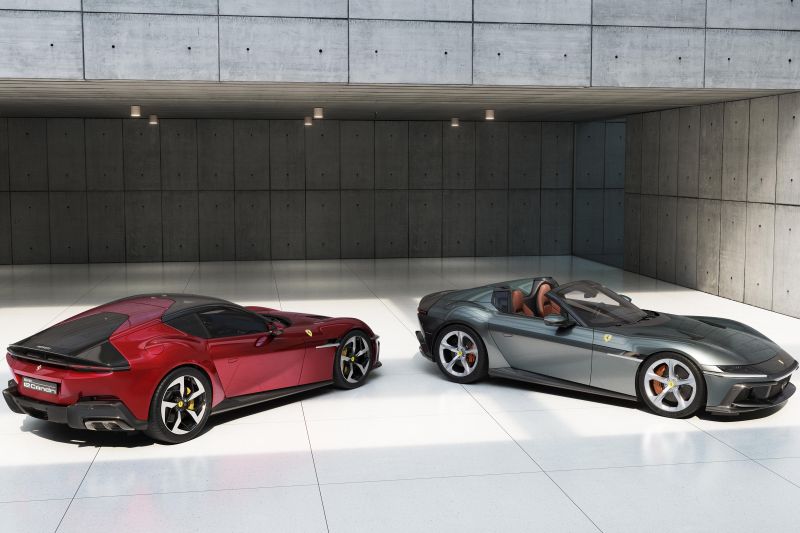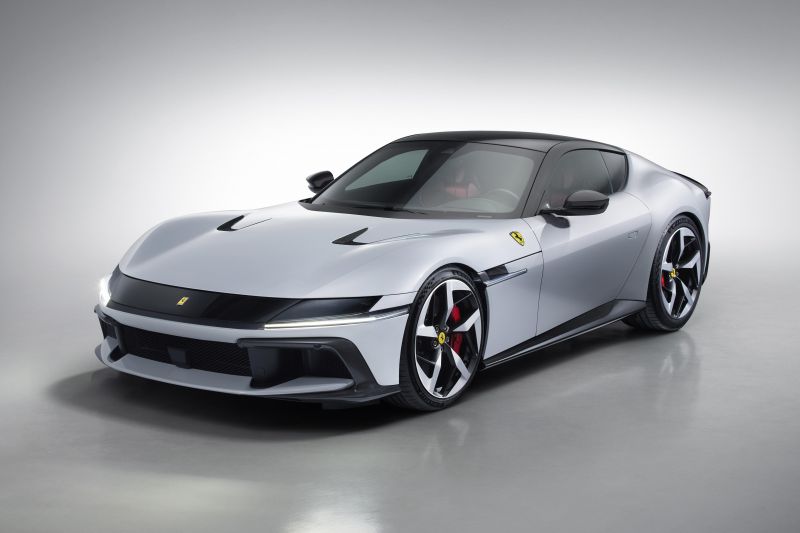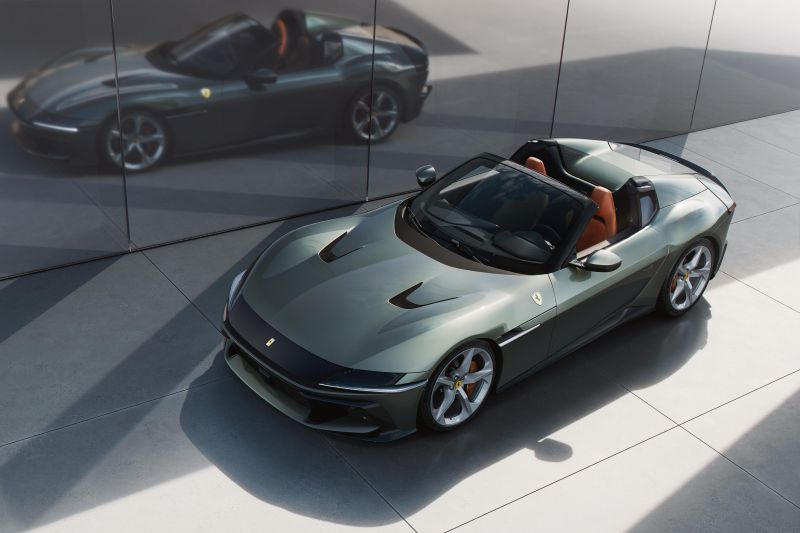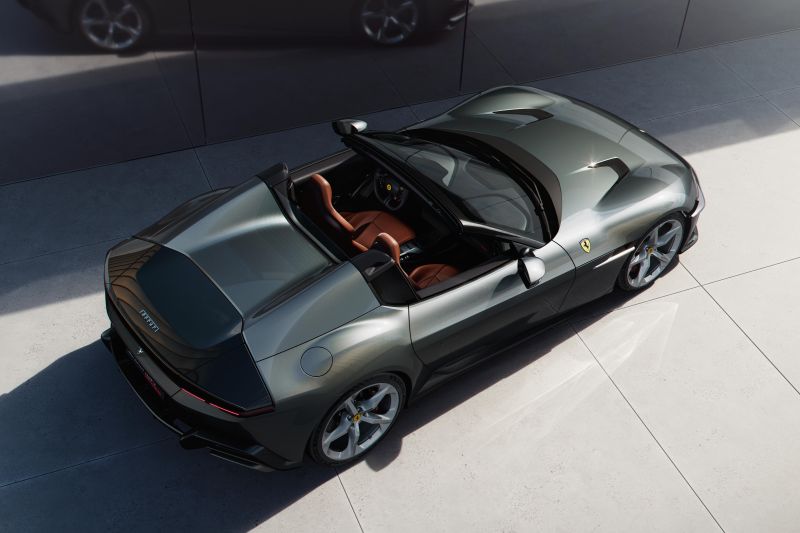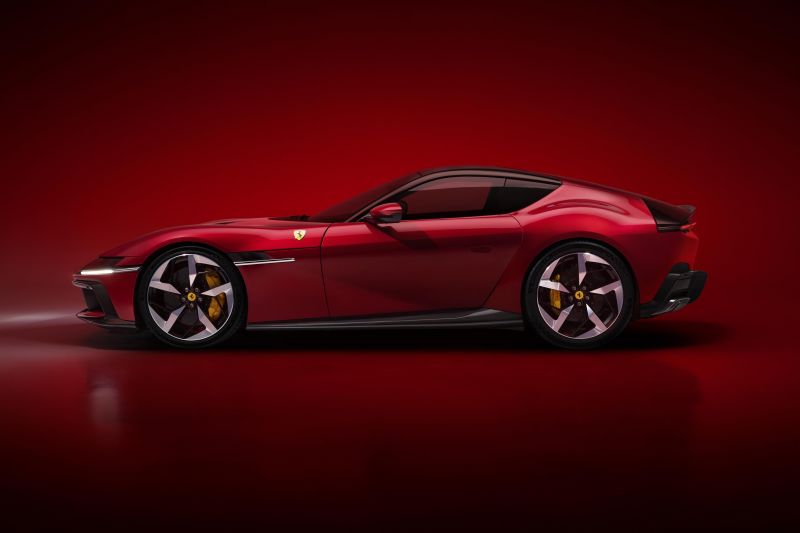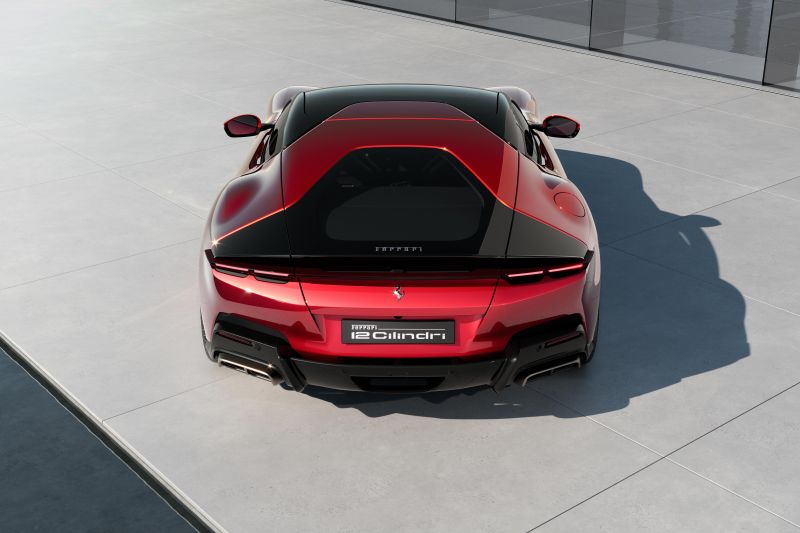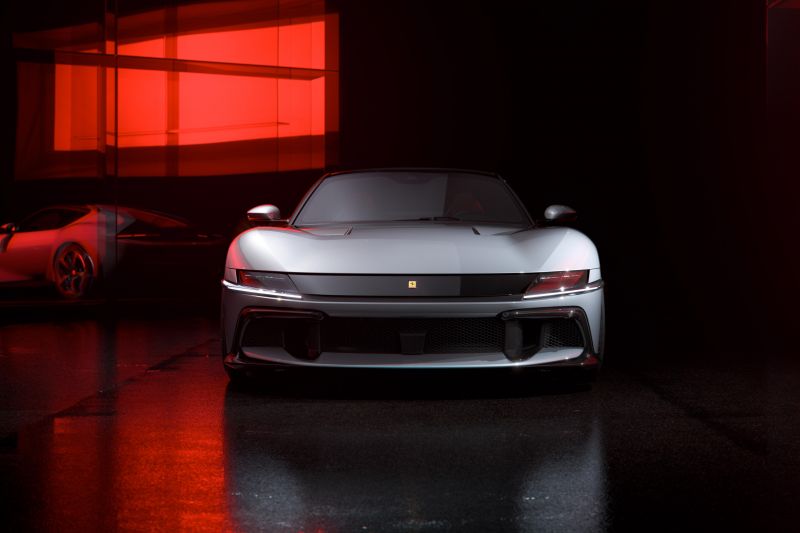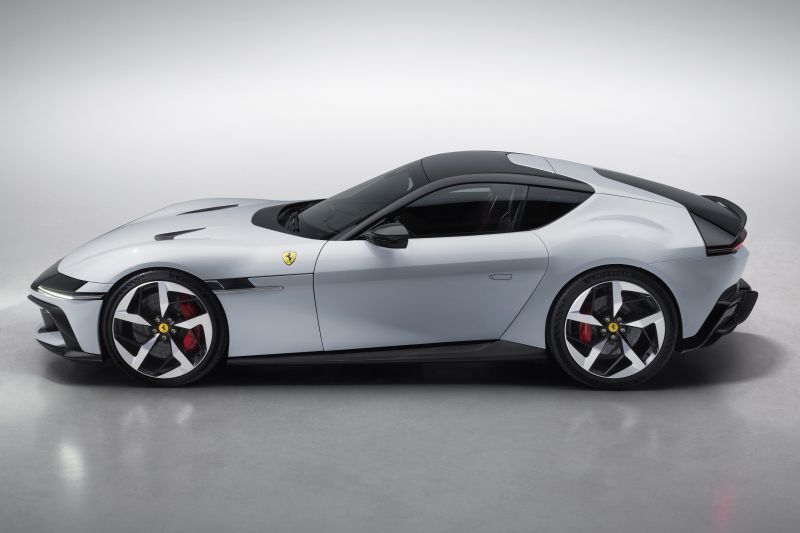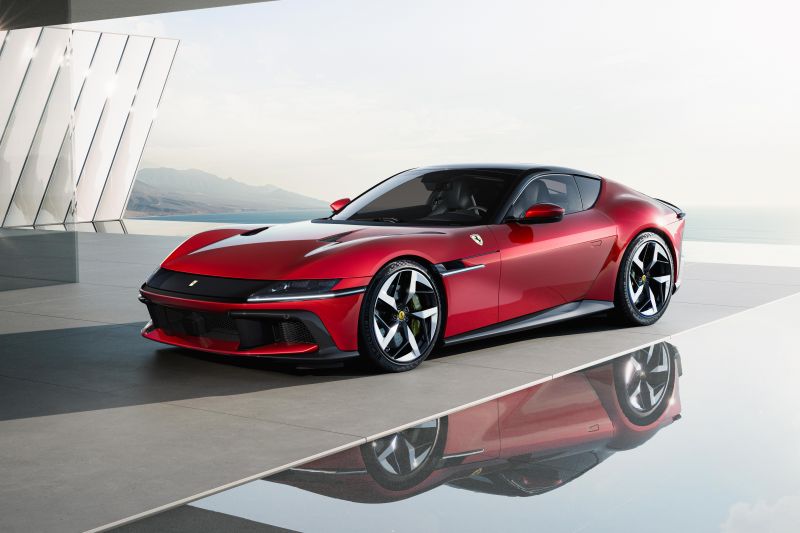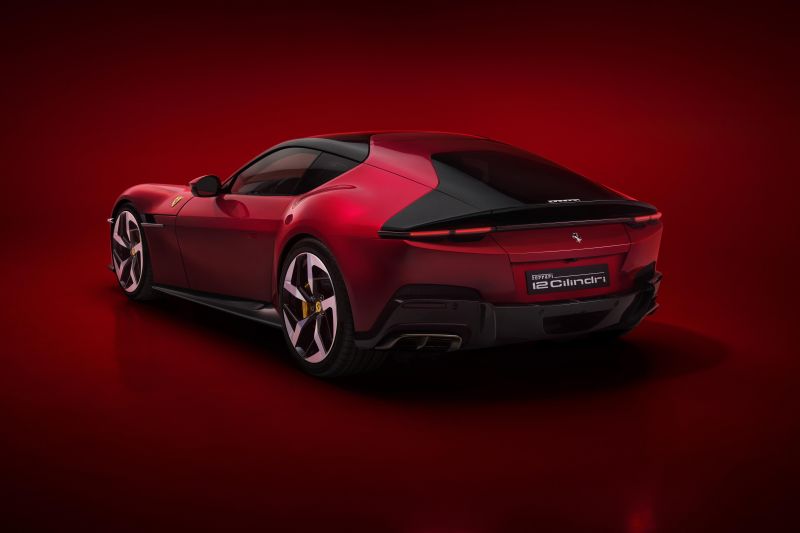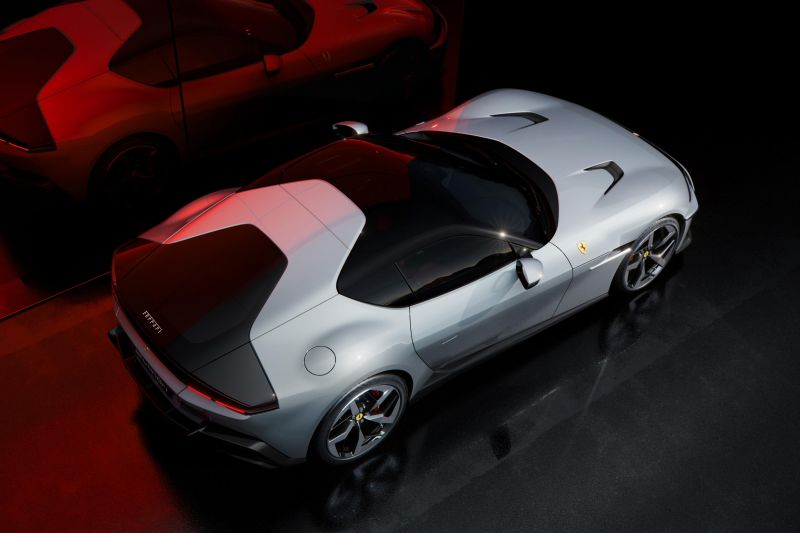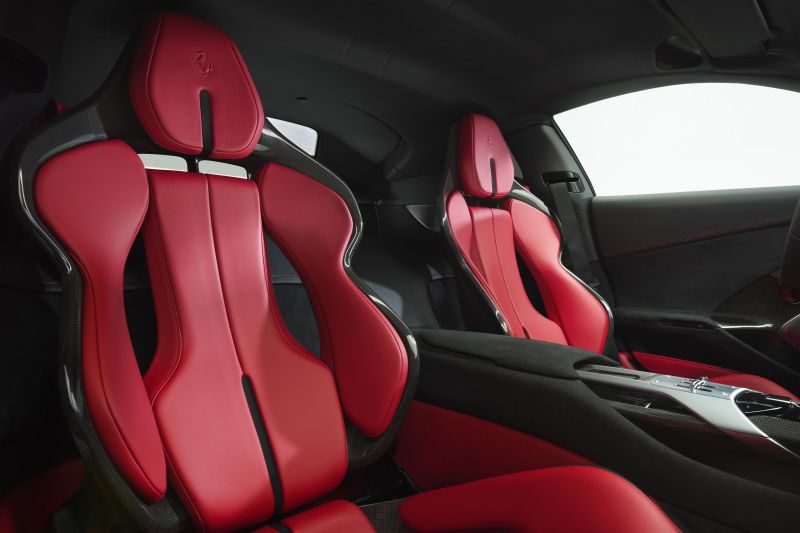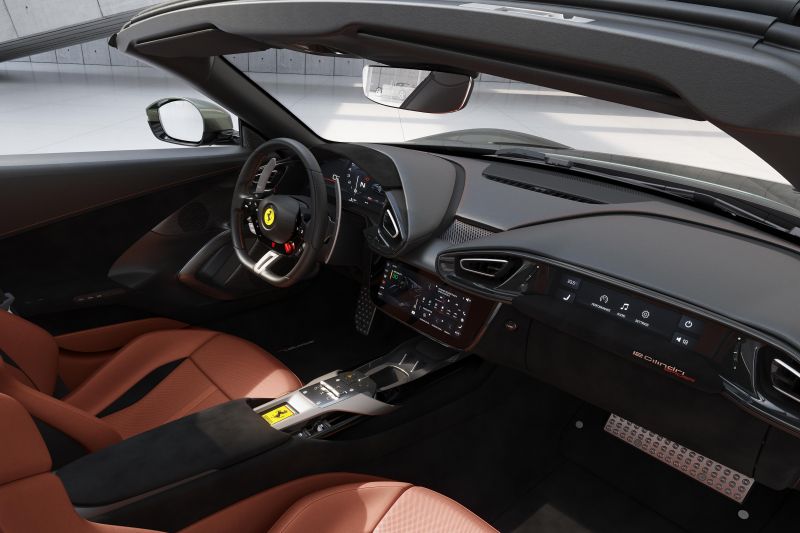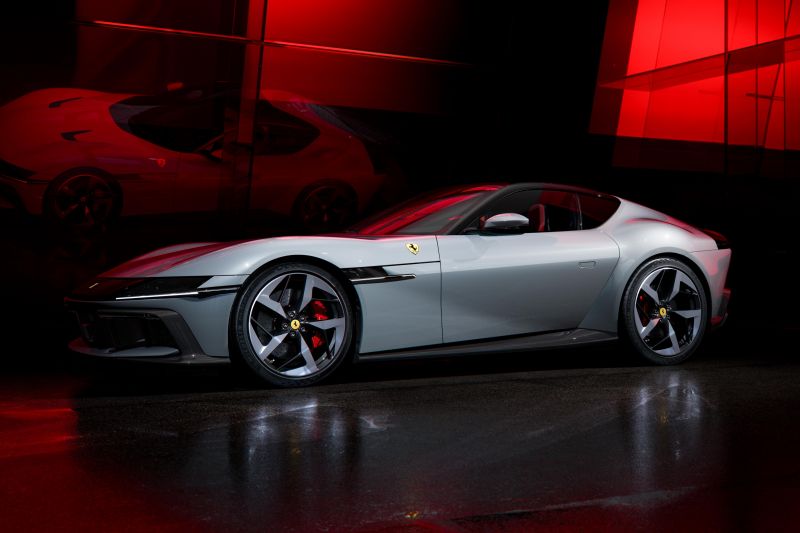
The Italian language makes the mundane sound magnificent. Nowhere else in the world could you get away with calling a sedan, simply, the Four-Door. Yet that is the literal translation of the name used for Maserati’s high-end sedan, the Quattroporte.
So, meet the Ferrari 12Cilindri. Italians pronounce it doh-dichee chill-indree, which sounds awfully exotic but literally means… 12-cylinder.
While that accurately describes what’s under the bonnet of this brand-new front-engine model from Maranello, don’t think for a moment that Ferrari’s marketing department has simply run out of ideas.
The 12Cilindri name adorns a car designed from the wheels up to be a celebration of Ferrari’s most iconic engine layout, the V12.
In simple terms, the 12Cilindri, which will be available as either a coupe or retractable hardtop Spider, replaces the 812 Superfast. But it also refocuses the role of the front-engine V12 two-door in a Ferrari lineup that now includes a four-door SUV and a six-cylinder, plug-in hybrid mid-engine sports car.
“It is not the top of the range in terms of performance,” says Ferrari’s chief marketing and commercial officer, Enrico Galliera. “It is the top of the range in terms of performance and comfort.”
The 12Cilindri has been designed to recall the spirit of iconic V12 Ferrari GTs from the past such as the Lusso and 275 GTB/4, cars which were very fast but also comfortable enough to be driven long distances.
But that’s not to suggest the 12Cilindri is a retro car, at least not in the conventional sense. Indeed, apart from a sly wink at the 1968 Ferrari Daytona in the way the black panel at the front of the car connects the headlights, the 12Cilindri is perhaps the first mainstream Ferrari since the brutalist Enzo that doesn’t obviously reference Maranello’s back catalogue.
The proportions of the 12Cilindri might echo those of a classic front-engine V12 two-door Ferrari, but its surfacing and graphics and detailing most emphatically do not.
Instead, says Ferrari’s chief design officer, Flavio Manzoni, they riff on the futurism seen in 1960s and 1970s Italian product design and architecture, and the visual aesthetics of movies such as Stanley Kubrick’s 2001: A Space Odyssey and George Lucas’s Star Wars, a point reinforced by the white paint on the 12Cilindri he unveiled for the media at Maranello.
“We wanted to create a car that was respectful to our tradition, but we also wanted to create something that was very modern,” explains Manzoni. And that philosophy extends to the engine under the 12Cilindri’s bonnet.
Ferrari’s first road car, the 125S, was powered by a V12 engine, and V12s have powered a string of fast and charismatic Ferrari road and racing cars in the 77 years since.
But the 12Cilindri isn’t merely another V12, says Ferrari chief product development officer Gianmaria Fulgenzi: “This is the V12.”
Codenamed F140HD, the 12Cilindri’s 6.5-liter V12 traces its origins back to the engine that powered the mid-engine Ferrari Enzo. Its basic architecture – a 65-degree vee with double overhead camshafts and four valves per cylinder – is thus more than 20 years old.
Officially, the F140HD is a comprehensive rework of the F140HC used in the 812 Competizione. Unofficially, many of its new, performance enhancing components and technologies were previewed in 2022 in the V12 that powered the limited edition, mid-engine SP3 Daytona.
It’s the most powerful naturally aspirated Ferrari engine in history. Able to rev to a screaming 9500rpm, the F140HD makes 610kW of power at 9250rpm and 678Nm of torque at 7250rpm.
Those dizzying crank speeds are the result of titanium conrods that are 40 per cent lighter than equivalent steel items, new pistons that are two per cent lighter than those used in the 812 Competizione’s engine, and a rebalanced crankshaft that’s three per cent lighter.
The engine’s 48 valves are actuated by sliding finger cam followers, a low-mass, low-friction technology borrowed from Ferrari’s F1 engines, and fuel is pumped into the combustion chambers via a direct injection system running at 350 bar.
The spent gases exit via a new exhaust system with equal length header pipes that feed into the ceramic catalytic converters and particulate filters that help the big V12 meet the tough Euro 6e emissions standards set for 2026 and beyond.
The F140HD drives the rear wheels through a new eight-speed dual-clutch transaxle transmission, giving the 12Cilindri an extra gear over the 812 Competizione.
This has allowed Ferrari to change the transmission’s ratios and shift pattern, and increase the torque transmitted to the rear wheels by 12 per cent while reducing shift times by five percent.
Ferrari claims the 1560kg (dry weight) 12Cilindri will accelerate from 0 to 100km/h in just 2.9 seconds, and to 200km/h in less than 7.9 seconds. Top speed is 340km/h.
Much of the 12Cilinidri’s suspension and braking hardware is carried over from the 812 Competizione, as is the differential. But the all-aluminum chassis, made up of extrusions and castings, is new and has a 20mm shorter wheelbase and 15 percent better torsional rigidity.
The 12 Cilindri also has the rear-wheel steering system that debuted on the 812 Competizione, but the rear wheels can be independently steered to further improve agility or stability when required.
Overseeing the 12 Cilindri’s chassis hardware is new software that makes the most of the six-axis vehicle motion controller and the brake-by-wire ABS Evo system that debuted on the 296GTB.
Dubbed SSC 8.0, this latest evolution of Ferrari’s innovative dynamic control system has a 10 per cent faster learning speed and a 10 per cent higher degree of accurately estimating vehicle behaviour in any given scenario.
Ferrari claims the system can now accurately measure the level of tyre grip even as the wheels are being steered.
Speaking of tyres, the 12Cilindri is available with Michelin Pilot Sport S5 or Goodyear Eagle F1 Supersport tyres, both of which were developed in new sizes specifically for the car: 275/35ZR21 at the front and 315/35ZR21 at the rear.
Standard wheels (seen on the green 12Cilindri Spider) are cast alloy, but wheels machined from solid billets of aluminium alloy (fitted to the white coupe) are available as an option.
The decision to opt for 21-inch wheels was driven by the design team, says Gianmaria Fulgenzi. His engineers would have preferred 20-inch wheels, which are lighter and so can be more precisely controlled by the springs and dampers and allow for quicker acceleration because of their lower inertia.
Adopting the 21s was just one of the hundreds of compromises between form and function that shaped the 12Cilinidri, however.
The original 3D aero model of the 12Cilindri was, says Flavio Manzoni, “a chaos of elements”. But such is the importance of aero, both in terms of performance and efficiency, that the team working under Ferrari’s head of exterior design Andrea Militello essentially treated the management of airflow paths and patterns almost like physical hardpoints around which parts the exterior of the 12Cilindri had to be shaped.
Balancing the demands of aerodynamicists with the desires of the designers led to an innovative method of ensuring the 12Cilindri remains stable at speed.
Based on the data streaming through the 12Cilindri’s sophisticated electronic neural network detailing the car’s speed and grip levels, movable flaps at each rear corner of the bodywork can be articulated as much as 10 degrees into the airflow between 60km/h and 300km/h.
The flaps work in tandem. They’re not needed below 60km/h, and above 300km/h the 25mm lip across the rear delivers all the stability the car needs.
At 200km/h, says Fulgenzi, the system delivers 50kg of downforce to the rear wheels. And, says Manzoni, it eliminated the need for a full-width active rear-wing, allowing the designers to endow the 12Cilindri with a surprisingly roomy boot, and to set up the bold delta-wing graphic that encompasses the rear window and is the Ferrari design chief’s favourite element of the car’s exterior.
“It’s a good example of how we worked together with the engineers,” he says.
As befits a car company that also owns an F1 team, much of the serious aerodynamic trickery lies under the 12Cilindri, out of sight.
On the front section of the underbody are three pairs of vortex generators that work with the front splitter to increase downforce on the front wheels.
The central part of the underbody is designed to channel air to the rear diffuser, and a further pair of vortex generators are located between the rear wheels.
A series of carefully designed and precisely placed vents direct less efficient hot air from the engine and radiators away from the cool air flowing through the underfloor’s downforce-generating elements.
More hot air is extracted from the engine compartment via the two vents on the bonnet.
The 12Cilindri is strictly a two-seater, though in addition to that roomy boot there’s a shelf behind the seats that can accommodate extra luggage.
The interior architecture, honed under the direction of Ferrari’s head of interior design, Fabio Massari, is defined by binnacles on either side of the cabin that wrap towards driver and passenger.
In the driver’s binnacle is a 15.6-inch digital instrument panel with the same functionality and configurability as in the Ferrari 296GTB and Roma.
In the other binnacle is a slim 8.8-inch screen that can be configured to display a variety of information to thrill, terrify or entertain the passenger.
Between the two is a landscape format 10.25-inch touchscreen that flies above a centre console with an aluminium structure that echoes the delta-wing graphic of at the rear of the car and houses the transmission shift toggles.
This exotic Ferrari also accommodates the everyday: Apple CarPlay and Android Auto connectivity is standard, and the centre console also has a wireless charging pad.
Standard seats are what Ferrari calls comfort seats with lightweight carbon-shell sports seats available as an option.
Coupe buyers can also choose between three roof options: glass, aluminium, or carbon fibre. The Spider’s folding hardtop can be raised or lowered in 14 seconds at speeds of up to 40km/h.
The 12Cilindri is also available with an optional 1600W Burmester sound system that has 15 speakers.
Having driven the SP3 Daytona, though, and experienced the sound, the fury, the wanton magnificence of taking its proto-F140HD V12 to 9500rpm, upshifts cracking like rifle shots as it stormed down the road, it’s hard to imagine why anyone would want to switch the sound system on.
Indeed, the 12Cilindri promises to deliver the most soul-stirring soundtrack of any modern Ferrari.
The 12Cilindri coupe goes on sale in Europe in the fourth quarter this year, priced in Italy at 395,000 euro (A$665,000), with the 435,000 euro (A$720,000) Spider arriving in the first quarter of 2025.
Production of right-hand drive cars won’t start until mid-2025, with the coupe slated to arrive in Australia in the second half of the year, and the Spider a few months later or early in 2026.
Click an image to view the full gallery.

